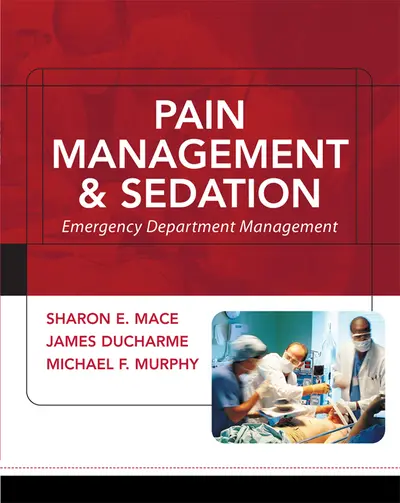My Account Details

ISBN10: 0071442022 | ISBN13: 9780071442022

Step 1 . Download Adobe Digital Editions to your PC or Mac desktop/laptop.
Step 2. Register and authorize your Adobe ID (optional). To access your eBook on multiple devices, first create an Adobe ID at account.adobe.com. Then, open Adobe Digital Editions, go to the Help menu, and select "Authorize Computer" to link your Adobe ID.
Step 3. Open Your eBook. Use Adobe Digital Editions to open the file. If the eBook doesn’t open, contact customer service for assistance.
Publisher's Note: Products purchased from Third Party sellers are not guaranteed by the publisher for quality, authenticity, or access to any online entitlements included with the product. DETAILED GUIDANCE ON PAIN RELIEF IN THE ED This thorough and informative text provides ready, expert answers to both everyday questions and to the often challenging, complex, and diverse issues that arise around pain management and sedation in the emergency department. Written by three leading authorities, Pain Management and Sedation provides in-depth, yet practical and easy-to-find guidance on relieving the complaint that brings more than 50% of patients to emergency care. A groundbreaking work, it is the first text to treat this important subject in depth from the emergency room perspective. Covering every aspect of the subject, Pain Management and Sedation offers Step-by-step guidance on approaches to patients, from preprocedure through discharge System-by-system patient evaluation protocols In-depth coverage of specific techniques, from conscious sedation through iontophoresis Drug-class by drug-class guidance on pharmacologic agents Specific guidance on pediatric, geriatric, pregnant, neonatal, and other patients with special considerations Coverage of useful techniques such as TENS, hypnosis, psychologic approaches, and other nonpharmacologic interventions Expert advice on key policy, administrative, and legal concerns EXPERT GUIDANCE Patient assessment protocols Drug regulations Drug-seeking patients Local and regional anesthesia Conscious sedation Drug therapeutics, with dosage charts Patients with special considerations Anxiety relief Nonpharmacologic interventions Legal and administrative issues
Section I: ADMINISTRATIVE
1.History/Background
2.Definitions
3.Regulations
4.Documentation/Standardized Forms
5.Quality Improvement/Risk Management
6.Legal Aspects
7.Policies and Procedures
Section II: APPROACH TO THE PATIENT
1.Preprocedural PatientAssessment
2.American Society of Anesthesia (ASA) Classifications
3.Pain Scales
4.Equipment
5.Procedural Patient Assessment and Monitoring
a.Airway
b.Respiratory
c.Cardiovascular/Hemodynamics
d.Neurologic
6.Post Procedure Evaluation
a.Discharge Criteria Assessment of Patient Stability
b.Patient Discharge Instructions
Section III: PHYSIOLOGY
1.Cardiovascular
2.Respiratory
3.Central Nervous System
4.Autonomic Nervous System
5.Renal
6.Hepatic
Section IV: PROCEDURE/TECHNIQUES
1.Conscious Sedation
2.Pain Management
a.Definition, acute vs chronic
b.Pathophysiology
c.The Drug Seeking Patient
3.Regional Anesthesia
4.Nerve Blocks
5.Local Anesthesia
a.Topicals
1.Vapocoolant sprays
2.Creams: EMLA, Eutetic, elemax
3.Combination Solutions: Tac, LET
b.Injectables
1.Amides
2.Esters
3.Long acting vs short acting
4.Others: Benadryl
c.Iontophoresis (numby)
Section V. PHARMACOLOGY
1.Muscle Relaxants
2.Neuromuscular Blockers
3.Adjunctive Medications
a.Atropine/Glycopyrolate
b.Lidocaine
c.Others
4.Reversal Agents
a.Naloxone/Naltrexone
b.Flumazenil
5.Agents for Conscious Sedation (Sedative Drugs)
a.Propofol
b.Etomide
c.DPT
d.Chloral Hydrate
e.Barbiturates
f.Benzodiazepines
g.Ketamine
6.Pain Medications
a.Opoids
b.Nonsteroidal
c.Acetaminophen
d.Others
7.Anesthetics
a.Inhalant anesthetics
b.Nitrous oxide
Section VI: SPECIAL CONSIDERATIONS
1.Devices
a.Transcutaneous Electrical Nerve Stimulation (TENS)
b.Continuous Infusions
2.Palliative Care
3.Pediatrics
a.Pediatrics
b.Neonates
c.Children with Special Health Care Needs
4.Geriatrics
5.
Need support? We're here to help - Get real-world support and resources every step of the way.